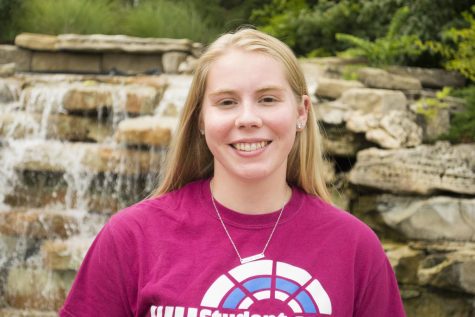Carnegie Hall faces another year without handicap accessibility
September 3, 2019
One common discussion students have about Washburn is that the current education building, Carnegie Hall, is not handicap accessible. This is an issue that students have brought up for years, so the question remains, “why has the campus not installed an elevator or renovated the building to make it more accessible to everyone?”
The biggest frustrations students like Clare Brindley, sophomore math education major, have is that they don’t see Washburn making accessibility an equal priority to new buildings on campus.
“We have an indoor athletics facility being built, we have a new law school being built…It needs to be taken care of,” said Brindley. “If we can have a new athletics facility, we can have accessible spaces.”
The building consists of three levels: the basement, first floor and the second. The only accessible floor is the basement, which houses the education departments library, but floors one and two house all the classrooms, yet a person with any sort of physical handicap would not be able to reach those classes.
Currently, if a student with a physical handicap wants to take a class that is normally taught in Carnegie Hall, the class will be relocated to a different building.
Gloria Dye, a professor for the education department who focuses particularly on special education, says that the building not being handicap accessible is a concern for the education department.
“We do occasionally have students that have a disability, and they’re not able to come up to our office,” said Dye. “We are concerned about being in a building, understanding the importance of accessibility, and yet our building is not accessible.”
By ADA regulations, Washburn is not required to make any accessibility modifications to Carnegie Hall. ADA compliance comes from the Americans with Disabilities Act, which was passed in 1990. This act outlaws discrimination based on disabilities, and this includes accessiblity to buildings.
In the past, to make Carnegie Hall ADA approved, the ADA compliance committee had to ensure that at least one floor was accessible, and in this case the library and basement level is accessible. They also had to make sure that there was at least one handicap bathroom stall for both genders, with accessible sinks, doors and hallways that were handicap accessible.
Dye, who is a former committee member of the ADA compliance committee on campus, says that Carnegie Hall actually is ADA compliant according to the specific regulations. As far as the law is concerned, Carnegie Hall meets ADA compliance.
“The checklist for ADA accessibility for a building has to do with ‘Is the building accessible?, Is there at least one floor or one level that can be accessible?’ and that’s true…it can be accessed,” said Dye.
So, although not every floor is accessible, the university is not required to fix this issue. Another reason Carnegie Hall doesn’t have a chair lift or an external elevator is because of the regulations put on them through the National Register of Historic Places.
According to the Kansas Historic Resources Inventory, Carnegie Hall was registered as a state and national landmark in 1987. The building qualifies as a national landmark because when the tornado of 1966 hit Topeka, Carnegie Hall was one of the few buildings on campus to be spared. At the time, Washburn used the building as the university library.
The historical society limits changing the external look of the building, so an external elevator would be incredibly difficult to add on while still maintaining the integrity of the building, and it also would be very costly.
Eric Just, director of facility services, said the solution to accessibility would be a large and expensive project for the university.
“Being able to make the second and third floor accessible would most likely require an elevator…which would be a major undertaking in a building that size and of that age,” said Just. “It would require new research and looking into if the cost of the elevator exceeds the cost of the building. In addition, other improvements that would have to go along with that.”
The accessibility of Carnegie Hall has been investigated in the past, and at that time an elevator, external or internal was brought up as a solution. However, according to Pamela Forster, Washburn’s equal opportunity director, Title IX coordinator and ADA coordinator, it was not something the university could do at the time.
“We did look at it [doing an external elevator] four or five years ago,” said Foster. “It was cost prohibitive.”
As of now, there is not a plan to alter Carnegie Hall, although it has been looked into many times.
Edited by Brianna Smith, Jessica Galvin



